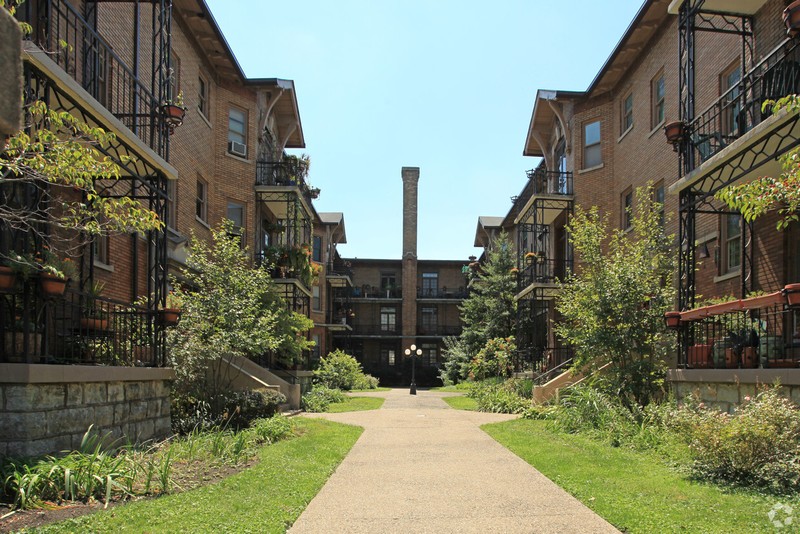Thierman Apartments
Introduction
Text-to-speech Audio
Images
Thierman Apartments in Old Louisville. The apartments were built in 1913.

From apartments.com, a photo of the Thierman Apartments courtyard

Backstory and Context
Text-to-speech Audio
The three-story, u-shaped Thierman Apartments (circa 1913) was completed toward the tail end of an era where many wealthy residents called "Old Louisville" home; Old Louisville was akin to a suburb of Louisville, known as the Southern Extension. While construction of grand homes and mansions occurred, there also existed apartment construction. The Thierman Apartments exemplify early twentieth-century architecture, notably the "Arts-and crafts"' movement that stressed simplicity, showcasing the beauty of materials, and relying on nature for inspiration. Its U-shape allows for a central courtyard, reminiscent of many Progressive-era ideas that sought to replace the old congested urban designs with ones that allowed residents to access fresh air. Additionally, the plan also provided more windows (more natural light) and included balconies; designers and housing reform advocates deemed access to air and light vital to one's health. But, the ornate details also note that the apartments also included features that catered to the middle-class, a sign of a trend where those with means began to accept apartment living as an acceptable, if not favored, choice of urban and suburban living.
The rise in construction of multiple-family residences slowly grew during the 1910s, eventually turning into a boom during the 1920s; an average of 226,000 multiple-family dwelling units arose each year from 1924-1928. For progressives, a move to rid urban areas of slums and replace them with apartments that offered access to air and light, and cross ventilation through open windows, was paramount to healthier people and society. For those with financial means, apartments often served as a cross between a residence and a hotel, with copious amenities. The seeds of the 1920s boom were laid during the 1910s when the Thierman Apartments emerged.
The Thierman Apartment building sits on a raised stone foundation and has an exterior consisting of orange-glazed bricks. Rising three stories, the U-shape allows for a courtyard that, along with the extra windows and balconies, allowed residents plenty of access to natural light and air, a fundamental aspect of the housing reform movements of the early twentieth century. Meanwhile, the ornate railings and exterior features speak to Old Louisville's reputation as a neighborhood dominated by beautifully-designed buildings, notably Romanesque, Queen Anne, and Italianate styles.
The elegant details also point to the building's purpose as an apartment complex for the middle class. So, while it followed many of the Progressive-era principles rooted in reforming urban communities -- ridding them of "slums," the apartments also demonstrate a trend in middle- and upper-class residents choosing apartments as they became better built and designed, often catering to those with various levels of wealth. In fact, until the early 1900s, many people, including government officials, connected apartment living to crime or at least deemed apartment living as enjoying less social status than single-dwelling homes. Thus, to see an apartment with elegant details notes how the acceptance of apartment living for those with financial means coincided with designers creating living spaces suitable for their social "status."
To view the Thierman Apartments today is to see several trends during the 1910s. The apartment building represents the architectural designs that matched the financial and social status of Old Louisville during the late nineteenth and early twentieth century, as well as trends in apartment designs tied to both Progressive-Era and middle-class ideals.
Sources
Babcock, Richard F., and Fred P. Bosselman. "Suburban Zoning and the Apartment Boom." University of Pennsylvania Law Review 111, no. 8 (1963): 1040-091.
Bluestone, Daniel. "Framing Landscape While Building Density: Chicago Courtyard Apartments, 1891–1929." Journal of the Society of Architectural Historians 76, no. 4 (2017); 506–531.
Hedgepeth, Marty. "Kentucky Historic Resources Inventory: Theirman Apartments." National Register of Historic Places. nps.gov. June 3, 1983. https://npgallery.nps.gov/GetAsset/75092d2a-dda5-4cd7-b488-5b6d847a1230.
Hoffman, Alexander von. "The Origins of American Housing Reform." Harvard University Joint Center for Housing Studies. 1998. W98-2. https://www.jchs.harvard.edu/sites/default/files/von_hoffman_w98-2.pdf.
Kleber, John E., ed. The Encyclopedia of Louisville. Lexington: University Press of Kentucky, 2014.
By Nyttend - Own work, Public Domain, https://commons.wikimedia.org/w/index.php?curid=29285141
https://www.apartments.com/thierman-louisville-ky/8mnwe51/
